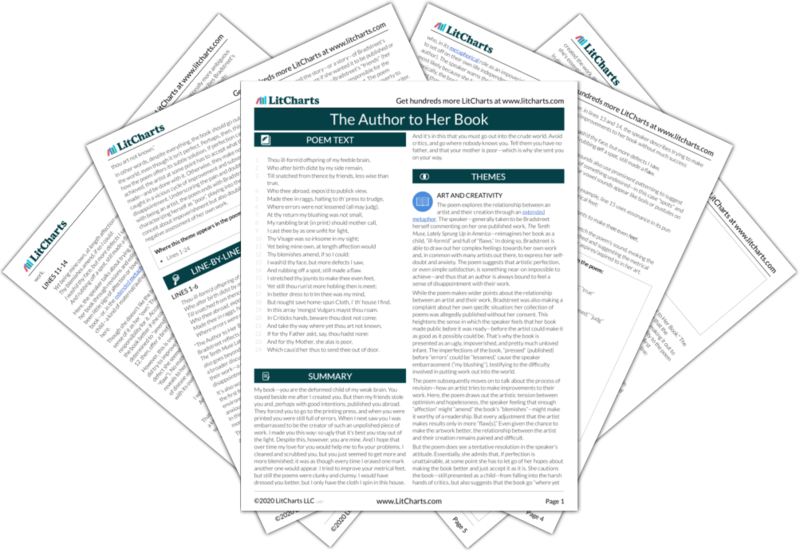
The Effect of Couplets in “The Author to Her Book” and “A Hymn to the Evening”
Poetry often employs various structural elements to enhance its meaning, rhythm, and emotional impact. Among these elements, couplets—two consecutive lines of verse that typically rhyme and have the same meter—play a significant role in shaping the reader’s experience. This article explores the effects of couplets in Anne Bradstreet’s poem “The Author to Her Book” and Phillis Wheatley’s “A Hymn to the Evening.” We will analyze how couplets contribute to the themes, tone, and overall impact of these poems while providing a comprehensive FAQ section at the end.
Overview of Couplets
Couplets can serve multiple purposes in poetry:
- Rhythm and Flow: The use of couplets creates a musical quality that enhances the reading experience.
- Emphasis on Ideas: Coupled lines allow poets to emphasize specific ideas or emotions by placing them together.
- Structural Unity: Couplets can provide a sense of closure or completeness to thoughts expressed within the lines.
“The Author to Her Book” by Anne Bradstreet
Summary of the Poem
Anne Bradstreet’s “The Author to Her Book” is a deeply personal poem where the speaker addresses her book as if it were her child. The poem reflects her feelings of inadequacy and embarrassment over her work being published without her consent. Through an extended metaphor comparing her book to a child, Bradstreet expresses both affection and disappointment.
Structure and Use of Couplets
Bradstreet employs heroic couplets—rhyming pairs of iambic pentameter lines—to convey her thoughts. The poem consists of 24 lines structured into 12 couplets. This structure plays a crucial role in shaping the poem’s emotional landscape.
Effects of Couplets in “The Author to Her Book”
- Emotional Resonance: The rhythmic quality of couplets enhances the emotional weight of Bradstreet’s reflections on her work. The steady flow created by the couplets mirrors her internal struggle as she grapples with feelings of pride and shame.
- Contrasting Feelings: The use of couplets allows for juxtaposition between Bradstreet’s affection for her work and her critical view of its flaws. For example:
- “Thou ill-form’d offspring of my feeble brain,” (Line 1)
- “Who after birth didst by my side remain,” (Line 2)
Here, the first line expresses self-doubt, while the second line reveals a sense of attachment, emphasizing the complexity of her emotions.
- Reinforcement of Themes: The couplets reinforce key themes such as authorial agency and maternal instinct. By addressing her book as a child, Bradstreet highlights her role as an author while simultaneously expressing vulnerability.
- Closure and Reflection: Each couplet serves as a mini-conclusion to specific thoughts, allowing readers to pause and reflect on Bradstreet’s sentiments before moving on to the next idea.
“A Hymn to the Evening” by Phillis Wheatley
Summary of the Poem
Phillis Wheatley’s “A Hymn to the Evening” is a lyrical poem that celebrates the beauty and tranquility of evening time. The speaker addresses nature, expressing gratitude for its beauty while reflecting on deeper spiritual themes. Wheatley’s work often explores themes of freedom, faith, and nature.
Structure and Use of Couplets
Wheatley also employs couplets in “A Hymn to the Evening,” creating a harmonious flow that complements her themes. The poem consists of several stanzas, each containing rhyming couplets that enhance its lyrical quality.
Effects of Couplets in “A Hymn to the Evening”
- Musicality: The use of couplets creates a melodic rhythm that enhances Wheatley’s celebration of nature. This musicality draws readers into the serene atmosphere she describes.
- Imagery Enhancement: Coupled lines allow Wheatley to paint vivid images through concise language:
- “When I behold, upon the night’s starr’d face,” (Line 1)
- “Shine out so bright, I feel my heart embrace.” (Line 2)
These lines work together to evoke a sense of wonder and appreciation for nature’s beauty.
- Spiritual Reflection: The couplets facilitate moments of spiritual contemplation throughout the poem. By pairing lines that express gratitude with those that reflect on divine creation, Wheatley deepens the reader’s understanding of her reverence for God.
- Emotional Impact: Just as in Bradstreet’s poem, Wheatley’s use of couplets allows for an emotional connection with readers. Each pair encapsulates feelings of awe and serenity, inviting readers to share in her experience.
Comparison Table: Effects of Couplets in Both Poems
| Aspect | “The Author to Her Book” | “A Hymn to the Evening” |
|---|---|---|
| Emotional Resonance | Reflects pride and shame | Evokes awe and tranquility |
| Imagery Enhancement | Uses metaphorical language | Creates vivid imagery through concise language |
| Spiritual Reflection | Explores authorial agency | Emphasizes gratitude towards nature |
| Musicality | Steady rhythm mirrors internal struggle | Melodic flow enhances celebration |
Conclusion
The use of couplets in both Anne Bradstreet’s “The Author to Her Book” and Phillis Wheatley’s “A Hymn to the Evening” serves distinct yet complementary purposes. In Bradstreet’s poem, couplets emphasize complex emotions related to authorship and self-doubt, while in Wheatley’s work, they enhance lyrical beauty and spiritual reflection regarding nature.By examining how couplets function within these poems, we gain insight into their thematic depth and emotional power. Both poets utilize this structural element effectively, allowing readers to engage with their works on multiple levels.
FAQ Section
1. What are couplets?
Couplets are pairs of consecutive lines in poetry that typically rhyme and have the same meter.
2. How do couplets affect poetry?
Couplets can enhance rhythm, emphasize ideas, create structural unity, and contribute to emotional resonance.
3. What is the theme of “The Author to Her Book”?
The poem explores themes such as authorial agency, self-doubt, maternal instinct, and vulnerability regarding one’s creative work.
4. What is the main theme in “A Hymn to the Evening”?
Wheatley’s poem celebrates nature’s beauty while reflecting on spiritual themes such as gratitude towards God.
5. How does Bradstreet use imagery in her poem?
Bradstreet uses metaphorical language by comparing her book to a child, which emphasizes her feelings about authorship and creativity.
6. What kind of imagery does Wheatley employ?
Wheatley creates vivid images through concise language that evokes feelings of awe regarding nature’s beauty during evening time.
7. Why are couplets significant in poetry?
Couplets provide rhythm and flow while allowing poets to emphasize specific ideas or emotions effectively.
8. Can you give examples from both poems?
In Bradstreet’s poem:
- “Thou ill-form’d offspring of my feeble brain,”
- “Who after birth didst by my side remain,”
In Wheatley’s poem:
- “When I behold, upon the night’s starr’d face,”
- “Shine out so bright, I feel my heart embrace.”
9. Where can I find more information about these poets?
For more information about Anne Bradstreet or Phillis Wheatley, you can refer to Wikipedia .
10. How do these poems reflect their authors’ experiences?
Both poets express personal emotions related to their identities—Bradstreet grapples with self-doubt as a female author in a male-dominated society, while Wheatley reflects on freedom and spirituality as an enslaved African American poet seeking recognition for her talent.By analyzing how couplets function within these two significant poems, we gain valuable insights into not only their structural components but also their thematic richness and emotional depth.


